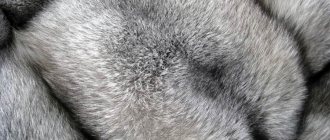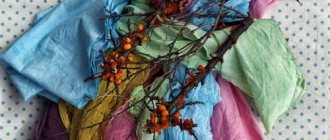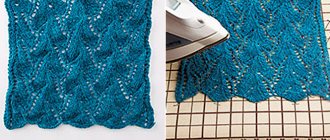Updated: 08.11.2021 15:21:17
Expert: Tatyana Hans
Sooner or later, owners of fur products come to the conclusion that things need cleaning. And here several questions arise - how to wash fur, is it possible to do this at all, can you use a washing machine for this or should you only use hand washing? Let's start with the fact that it is recommended to dry-clean expensive items made from natural or artificial materials; they should be processed only by professionals who have the skills, experience, specialized cleaning products and equipment. If you wash a fur coat, short fur coat, vest at home, they can become deformed and shrink. If it is not possible to dry-clean your item, you can try dry cleaning at home; later in the article we will dwell on this topic in more detail. Collars, removable cuffs, and natural fur trim can be washed by hand or in a washing machine. However, you must strictly observe the correct washing technique so as not to spoil the item. It’s better not to take risks and trust the professionals, but if you prefer to wash it yourself, we’ll tell you how to do it as safely as possible. Regarding faux fur products, they can be safely washed both in an automatic machine and by hand. Manufacturers of such clothing focus consumers’ attention on the fact that their products are machine washable.
How to wash real fur by hand
Experts once again warn: wash products made from natural fur only if you are confident in your abilities. So, the sequence of actions:
- We unfasten metal elements, decorative parts, inserts, and in general everything solid that can be removed from the object.
- We fill the washing container with warm water, dilute it with a specialized detergent for washing delicate fabrics, or better yet, baby shampoo, the best option is animal shampoo (veterinary). The latter remedy is best, since in theory it does not contain aggressive chemicals that have a negative effect on the fat protection; if it disappears, the base (the inner layer) will loosen, and the villi will begin to fall out. After pouring the shampoo, beat the foam with your hands.
- We immerse the thing in water. We don’t knead, we don’t squeeze, we just stroke the fur with light movements and wipe it in the direction of the growth of the pile.
- Gently comb the fur using a wide-toothed brush.
- We take out the product from the soapy water, take new water, add a few tablespoons of ordinary 9% vinegar to it. We immerse the item in water and let it sit for 2-3 minutes.
- Change the water again, this time pour cold water, since it is recommended to rinse at low temperatures, because cold water covers the hair scales, as a result, the fur will shine after drying. You need to rinse the product in as many changes of water as necessary so that the resulting water is completely transparent and without a hint of foam.
- Carefully squeeze the item with your hands, do not twist it.
It is recommended to dry natural fur on a flat surface, in a horizontal position, after laying a terry towel under it. Drying should take place in a ventilated room with well-circulated air, away from heat sources (including the use of a hair dryer to speed up drying). There should be no strong-smelling objects around, otherwise the smell may be absorbed into the fur. After the item is completely dry, carefully comb the lint, moving in the direction of its growth.
How to wash in water
If the described methods do not help clean the clothes, and you cannot get to the dry cleaner, then you can take a chance and wash it in water. It should be understood that the answer to the question “can fur be washed?” an unequivocal “no”. Therefore, any independent attempts are a big risk. You can, of course, see a lot of phrases on the Internet: “I washed it, and everything is fine,” but this is not a guarantee that it will be the same for you. Natural fur can become deformed, stretch, shrink, in other words, deteriorate or lose its original appearance. If you are ready to take a risk, then consider the most gentle way to wash natural fur.
First, check that your fur item can withstand washing. To do this, prepare a solution of 50 ml of water, 1 drop of shampoo and 2 drops of ammonia. Apply it to the fur in an inconspicuous area, pull the fur in different directions, and if there is no deformation of the fur, it does not tear, then perhaps your clothes will survive the wash, or at least not come apart.
Must be washed by hand . Of course, you can wash fur in a machine, but only to see how badly it will deteriorate. Mechanical washing is strictly contraindicated. It's not even considered.
- Start washing in water only after dry cleaning has already been completed, i.e. dust and fine dirt are knocked out. Otherwise, the water will only drive them further into the canopies, cementing them, so to speak.
- Take a detergent special for fur. If there is none, then regular shampoo or pet wash will do.
- Water temperature – up to 40 degrees. There should be enough of it so that the fur product completely goes under water.
- Soak the natural fur for 15-20 minutes. There is no need to rub, crush, or press it, otherwise you will ruin the pile. If there are old stains of dirt, you can scrub them with a soft brush.
- Drain the soapy water and add clean water. Rinse thoroughly several times. It is necessary to wash out all the soap solution.
- Don't twist it. It is enough to iron it with your palm in the direction of the pile, driving out the water. Next, hold it suspended until the liquid drains.
- If you wash a large fur item, for example a fur coat, then you will have to hold it for a long time until it drains. Place a chair with a backrest in the bathroom and hang it on it for at least 6 hours.
- A small piece of fur, such as a collar, can be wrapped in a terry towel to absorb excess moisture.
- The dried fur is combed with a wooden comb as far as possible. Next, hang it out to dry in a ventilated place. Not under a heater, not under the sun.
- Once it dries, comb it again.
With this, the question of how to wash natural fur can be considered resolved. If the fur remains unchanged, then you are very lucky. Well, if it’s spoiled, don’t be sad, there are many solutions for what to do with it: peel it, give it as a gift (if it’s worn out), use it under a rug.
How to wash natural fur and not spoil the product
Washing in a washing machine
Washing items made from natural fur in a washing machine is an even more risky undertaking than washing by hand. But if you decide to do this, there is nothing complicated in the procedure. We set the most delicate mode on the machine panel - for silk and wool or down products. Or you can simply set the temperature to 30-40 degrees, the processing time is 30 minutes, without spinning, or with an additional rinse. We place the product in a special mesh or fabric bag made of white cotton fabric, load it into the machine (we do not wash any other things at the same time as fur). After completing the process, wring out the product, straighten it, and let it dry on a terry towel.
Machine washable
Only items with short and thick fur are suitable for washing in a machine, then it will not get tangled. Do not rush to turn on the delicate mode - the product cannot be washed. If this is a front-loading washing machine, then only the soaking mode will do, and “vertical” machines need to be filled with water up to half the drum.
Let the item sit in soapy water for about half an hour, after which you can start rinsing. If possible, it should be delicate, but many washing machines do not have such a mode. Then it's better to do it manually.
Do not leave the fur in water for a long time, otherwise the fabric base may become very wet, and the pile will deteriorate from the large amount of moisture!
You can't squeeze the item too hard. Hang it on a hanger above the bathtub or basin - the water will drain by itself. If this is a bulky blanket, then it is better to use a stick for drying; the clothesline can break from the heavy weight.
Features of washing products made from different types of natural fur
Let's look at how to wash or clean clothes made from the fur of different animals. Features of the procedure:
- Rabbit
. Before washing, be sure to ensure that the product is in good condition and will withstand the cleaning procedure. To do this, hold a small tuft of wool in your fingers and pull it slightly. If there are a lot of hairs left in your hands, it means that you cannot wash the product yourself; it is better to take it to professionals. Otherwise everything is standard.
- Arctic fox
. It is strictly not recommended to wash such products either in a machine or by hand. The inside of the item should not get wet. It may come into slight contact with water, but significant moisture ingress into the area near the roots of the villi and on the inside of the product is detrimental to it. Therefore, in order to somehow clean the product, restore shine and volume, you can carry out dry or wet cleaning. Dry is done using talc or crushed stationery chalk. The product is laid out, sprinkled with absorbent, it needs to be washed, then shaken and combed with a brush. To obtain the desired result, you may have to repeat the procedure up to 3-4 times. Wet cleaning is carried out using plain water, water and ammonia, water and shampoo. Pour any of the listed mixtures into a bottle with a spray bottle, spray the product onto the fur so that it becomes damp, but not wet, wipe the pile with a cotton or gauze swab. After this, you can take new tampons, moisten them with clean, cool water and wipe until completely free of detergent.
- Raccoon.
This fur, like arctic fox fur, is extremely demanding to care for and incredibly difficult to clean. It must be cleaned dry using grated chalk or talc. You can also wipe it with a damp swab, but only on the tops. During the cleaning procedure and during the drying process, raccoon fur must be constantly combed using a stiff brush with metal teeth, since the density of raccoon hair is increased.
- Fox.
Experts also do not recommend washing products made from the fur of this animal, since moisture should not get on the inside. Acceptable cleaning methods are dry and wet, by wiping the fur with a solution of water and animal shampoo.
Adding shine to fur
How to clean mink or arctic fox fur if it has lost its former shine? In order to return a fur coat or hat made of natural fur to its previous condition: rabbit, silver fox, chinchilla or sheepskin, you can use folk remedies that will solve your problems not only in, for example, how to clean the fur of an arctic fox, but also of any other animal.
Alcohol and ammonia
- Mix table vinegar and citric acid in a 1:1 ratio.
- Treat the fur.
- Let sit for 10 minutes.
- Remove the product thoroughly.
Fish fat
- To 1 liter of boiling water, add: 10–12 drops of ammonia, 100 grams of fish oil and 10 grams of dark laundry soap.
- Cool the solution to 30–35 degrees.
- Apply the solution to the fur.
- Leave for 5-10 minutes.
- Remove any remaining product.
Dry cleaning method
Obviously, most fur items are not washable in the classical sense of the word. And if some things can be washed, then this should be done by professionals; home processing can lead to damage to the product. However, you can clean your clothes using dry or semi-dry cleaning methods. We already wrote above that for this you can use chalk and talc, dog shampoo diluted in water. Let's consider what other means can be used for such purposes. But first, a piece of advice - before you start cleaning, shake the product thoroughly, knock the dust out of it, and vacuum it using a special attachment for upholstered furniture.
Additional products for dry and semi-dry cleaning of fur items
(it is better to carry out the procedure in the fresh air or in the bathroom, so that you do not have to do a general cleaning of the room later):
- Flour.
- Oatmeal ground in a blender or coffee grinder or meat grinder.
- Water with hydrogen peroxide.
- Sand.
- Starch.
- Small sawdust.
Keep in mind that food products (flour, oatmeal, etc.) used during cleaning may attract the attention of insects, in particular moths. If you do not completely remove such an improvised cleaning agent from the pile, insects can damage both the interior and the pile.
Traditional methods
All these methods have been successfully tried by many women; they help clean fur without contact with water, without spoiling it. Some methods will require time and patience, but the results are worth it.
You can use flour, but not traditional wheat, but rye or oatmeal. Oatmeal crushed in a blender or coffee grinder will also work.
- It is necessary to pour flour into a large basin so that it occupies 1/3 of the space.
- Place the contaminated item in a basin and roll it in flour on all sides.
- You should act energetically, so it would be better to carry out the procedure in the bathroom.
- Shake the flour off the product.
- Vacuum any remaining flour using a furniture attachment.
- Hang the fur coat on a hanger in the closet for a day.
- Comb the product, removing any remaining flour.
Hydrogen peroxide
For items where dirt is most visible, you can use a delicate cleaning method. This algorithm was created specifically for a white or light fur coat, the material of which is mink or arctic fox.
- Soak a cotton swab in hydrogen peroxide.
- Moisten the teeth of a plastic comb with a cotton swab.
- Comb the item well.
- Walk a cotton swab soaked in hydrogen peroxide over the entire surface of the product.
- Allow the product to dry and comb it again.
This method allows you to remove not only dirt, but also the yellowness that appears over time.
Petrol
Cleaning of silver fox products should be carried out in an open space so that the living space is not saturated with the smell of gasoline. It is best to use a coffee grinder to grind bran.
- Mix crushed oat or rye bran with a small amount of gasoline. Instead of bran, you can use small sawdust.
- Hang the item on a hanger, and hang the hanger on the crossbar.
- Using rubber gloved hands, apply the mixture to clothing.
- Comb the product well and air it for an hour or two until the smell disappears.
Sand
It is best to use this method on fur products with a minimum number of seams, since sand can get stuck in them and is not easy to get out. This method is best for cleaning bedspreads, blankets, fur capes and stoles.
Heat a thick cast iron skillet.
- Pass river sand through a sieve and pour into a frying pan.
- Heat the sand until hot, but so that the temperature is tolerable for the hands.
- Spread the item on a flat, flat surface and sprinkle it evenly with sand.
- Gently rub the sand into the pile, removing dirt.
Color protection
To clean sheepskin, you can use a delicate method, which will take some time, but the product will definitely not deteriorate or lose its original color. This method is also very good for rabbit items.
- Take a special comb with rounded teeth for cleaning fur.
- On each clove, wrap a piece of cotton wool soaked in alcohol or kerosene or in a warm soap solution.
- Secure the cotton pieces with a cotton thread at each clove.
- Comb the fur along the hairline.
- Hang the product outside or on the balcony until the characteristic unpleasant odors disappear.
How to clean natural fur from yellowness
Over time, the fur on the product may turn yellow. This does not make the item more attractive, so many owners of fur clothing try to return the pile to its natural color. This can be done using a product that is prepared according to a simple recipe - mix one tablespoon of ordinary table salt and half a tablespoon of ammonia in half a glass of water (we work in a respirator so that the smell of ammonia does not irritate). Then take a soft cloth, preferably white cotton, dip it in the solution and wring it well, it should remain barely damp. We wipe the fur with a cloth, especially carefully treating the yellowed areas. This way we remove greasy contaminants that give the fur an unsightly tint. After this, shake the fur product, straighten the fibers, and leave to dry.
Tips from the experts
Experts in the field of caring for fur products give several recommendations that will help you carry out the cleaning procedure effectively and safely:
- Never use dry washing powders for washing. It is also prohibited to use any household or homemade stain removers or bleaches.
- Never twist wet fur items, as this will harm both the fur and the lint.
- Fur should not be dried in direct sunlight or near heating appliances.
Well, the last recommendation is that fur should never be ironed, even from the inside out, so you should not do this either.
How to dry it properly?
Regardless of how the faux fur coat is cleaned, it must be dried properly afterwards.
Preserving the original appearance of a fur product is not difficult if you follow certain drying rules:
At the end of washing, the faux fur coat is carefully hung on hangers, not forgetting to provide a basin for the draining water. Hang the fur item to air dry, away from heating devices, in the shade (direct sunlight dries out the pile). During the drying process, the fur product is periodically shaken, thereby preventing fur creases. Long pile can be combed using a comb with wide, blunt teeth
Attention: creases and tangles in the pile of long fur can only be corrected during the drying process. Once the fur coat has dried, it will be very difficult to correct such problems. Short-pile fur can also be combed with a comb, but to ensure that the fibers do not stick out and take the correct position, it is better to use a soft brush for such purposes. During the drying process, the fur coat is periodically straightened out on hangers.
Faux fur items should never be ironed. Machine drying is also prohibited. Exposure to high temperatures is detrimental to artificial fur products.
Ignoring these rules will result in the fur being damaged beyond repair and the fur coat will have to be thrown away.
How to wash faux fur items
Products made from synthetic fur are hand washed in the same way as items made from natural materials. Machine washing on a delicate cycle is also allowed, but only if the length of the pile does not exceed three to four centimeters. You can dry clothes in the standard way - on a horizontal surface, on a terry towel, in a well-ventilated room.
When is the best time to turn to professionals?
Of course, experts recommend going to dry cleaning whenever you need to wash or otherwise clean a product made from natural fur, especially such expensive types as arctic fox and mink. But if your clothes become heavily soiled, you definitely cannot do without the services of professional dry cleaners. When to call a specialist:
- If there are dirty stains on the clothes from precipitation (snow, rain).
- If there are traces of reactive salts on the product, especially on the hem, which utility workers sprinkle on roads and sidewalks in the winter.
- If there are stains of unknown origin, traces of cosmetics and other foreign substances on things.
- If the product is heavily soiled, it is impossible to clean it yourself at home.
Experts advise dry cleaning fur clothes at least once a year, the optimal time being spring. Professional cleaning will not only return the product to its aesthetic and attractive appearance, but will also prevent the occurrence of moths, which, as we know, can easily ruin the most expensive fur product. The cost of dry cleaning items made from natural or artificial material depends on several factors, in particular, the location of the company, its reputation, the length of the item and the complexity of its cut; on average, it is approximately 5,000 rubles. But, you must admit, a fur coat or other product costs much more, it is better to pay for professional care than to spoil the item and face the need to buy a new one.
Fur items require proper storage and care conditions
Basic rules here:
- Fur coats should be hung flat on hangers
- In the warm season, it would be good to put hats on blanks (for example, a cardboard cylinder of a suitable diameter, close to the size of the head) so that they do not become deformed, there are no creases, etc. It is better to store hats in ventilated boxes, like hats, but not in plastic bags
- Never dry on a radiator or store near heating devices.
- During storage, branches of fragrant geranium, tobacco or citrus fruit peels will help protect fur from moths.
- It is ideal to store or transport fur products in special “breathable” covers. A snow-white shade of an initially white item (fur coat or hat) will help preserve the blue color of the case
- Ironing, of course, is prohibited, even the lining
- Do not use chemicals containing chlorine for cleaning
- To protect the lint on the sleeve cuffs and collar from abrasion, it is recommended to wear silk scarves around the neck and muffs on the arms.
- Do not leave fur coats and hats in the light for a long time, especially in the open sun, as light-colored items can acquire a yellow tint over time, while dark-colored items fade quickly.
Methods for cleaning fur products
To remove tangles (clumps of matted wool) and other types of mechanical contaminants at home, you can use abrasive materials available to everyone: semolina, bran, talc or starch.
They are able to level and polish the texture of the product, do not stick and are easily removed. One of the listed products is poured into a frying pan for slight heating. Then they rub it into the pile (again, without fanaticism), shake it off or clean it off the surface with a soft brush.
Another effective method from this series is the use of sawdust (you can buy, for example, in the pet department). The sawdust is first moistened and soaked in a small portion of alcohol. Then they apply it to the contaminated surface, give it time to absorb the dirt, and shake it off. The only caveat is to make sure, at least by smell, that the sawdust is not from coniferous trees containing resin. Otherwise, there will be a risk of not cleaning the product with them, but rather getting dirty.
For removing stains of grease, paint, etc. they use gentle chemicals, which, in addition to cleansing, are designed to help restore the silkiness of the fur to the touch, increase the strength, flexibility and elasticity of the skin under the pile. Let's take a closer look at these methods.
Method 1.
Let's say there is a need to soften and restore the former elasticity of the skin under the fur. To begin with, lightly trim the seams at the lining of the product so that there is access to the interior.
The flesh is slightly moistened with a “cocktail” of 1 tablespoon of water, 1 tablespoon of vinegar essence and ½ spoon of salt. The wet material is pulled very carefully in all directions. Vinegar will also help in cases where the pile has lost its shape and shine. It is necessary to wipe the surface of the fur, without exposing its base, with a cloth moistened with the solution.
Method 2.
If the flesh has hardened as a result of thoughtless drying using heating devices, you can wipe it with alcohol or vodka diluted with water.
Method 3.
To soften, for example, a leather item upholstered with fur, glycerin water is well suited. Its use will prevent the base of the collar from hardening, and will give the collar pile a silky appearance and feel.
Method 4.
Dissolve a small amount of shampoo for washing pets in warm water, moisten a regular sponge in this solution and clean the fur without much effort. After this procedure, simply blot the wool with a cotton cloth or dry napkin. This is a particularly effective method for products made from arctic fox, fox, and silver fox.
Method 5.
A mixture of water and gasoline taken in equal proportions effectively removes grease stains. Contaminated areas are also wiped with a sponge soaked in the solution, and then with wet wipes.
Method 6.
You can try to clean problem areas (stains from grease, sweat) with the following composition: water, ammonia, transparent dishwashing gel. Everything is taken in equal parts. After cleaning with a sponge soaked in this solution, the pile is again blotted with a napkin.
Method 7.
Or this solution for the previous problem. Mix ammonia (1 teaspoon) with salt (3 teaspoons) and water (5 teaspoons). Using a sponge soaked in the mixture, treat the stain from grease or sweat.
Method 8.
A mixture made from starch and gasoline will help remove yellowness on light-colored items, as well as stains from foundation on the fold of the collar. The ingredients are mixed until creamy, scooped onto a sponge or brush and treated the contaminated area.
Then they dry it. This cleaning method is effective even on old dirt or hardened stains. Gasoline scrubs, and starch absorbs dirt. After this procedure, shake the product well, and the stain will be removed along with the starch. And the smell of gasoline will disappear after drying in the open air.
IMPORTANT!
To eliminate the smell of gasoline, you should not spray perfume on a light-colored item. Yellow spots will remain!
Method 9.
How to clean mink fur at home? A mixture of water, alcohol (including ethyl) and vinegar mixed in equal proportions will help to scrub products made from mink fur, as well as rabbit, goat, and wolf fur. After cleaning, wash off the fur coat or boots decorated with fur parts with a sponge soaked in warm water.
Method 10.
Items made from the skins of waterfowl (muskrat, beaver) can be easily cleaned with dry river sand. It must be sprinkled on the product and removed with a brush along with any dirt.
Method 11.
Following the previous example, rabbit fur is effectively cleaned with wheat bran.
Method 12.
In most cases, the scribble will return to its original appearance after strong shaking. It is more rational to store astrakhan products in the future by stuffing them with paper or fabric material in order to prevent loss of shape. To clean astrakhan fur, river sand, rye flour, bran or semolina are used. But after using them, they require more thorough shaking than in the case of other straightened bellows.
Method 13.
Oil paint stains can be easily removed with sunflower oil. Using a piece of cloth or a sponge soaked in oil, carefully wipe the stained area against the growth of the lint. Rinse off with a damp cloth.
Method 14.
Acetone or white spirit will help remove marks from a ballpoint pen. Add a drop of lemon juice to warm water to rinse off to eliminate the unpleasant odor.
Method 15.
Rubbing alcohol will remove traces of lipstick or other makeup. Clean with a soaked cotton pad.
Method 16.
The fur has turned yellow, how can I clean it?
A mixture of a spoonful of salt and 1/2 spoonful of ammonia dissolved in water will help to remove yellowness from even white items. Hydrogen peroxide gives the same whitening effect.
A damp cotton pad is moistened with the chosen product and the fur is wiped. Bran is also effective against yellowness; it is slightly heated in a frying pan, applied to the product and shaken off after a while.
IMPORTANT!
Comb the fur only in the direction of hair growth, otherwise it may break out.
After cleaning an item made of natural fur using one of the methods listed above, shake the item thoroughly, straighten and smooth the pile with your hand, and wear the updated item of clothing carefully and with pleasure.
How to clean faux fur at home?
This material is not as vulnerable and demanding to care for as natural fur, and yet care in relation to it is not canceled. If stains appear, it is more rational to clean the product immediately, without delaying it, since otherwise the material may become deformed.
IMPORTANT!
Acetone and vinegar should not be used to clean faux fur from dirt.











